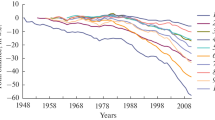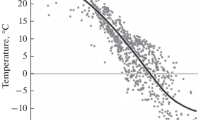Abstract
Based on the astronomical ephemerides DE-406, theoretical calculations have been performed of the interannual variability of the Earth’s insolation related to celestial-mechanical processes for 365 points of a tropical year in the time period from 1900 to 2050. It has been determined that the average amplitude of variations of the interannual insolation is 0.310 W/m2 (0.023% of the solar constant). The calculated variations are characterized by strict periodicity that corresponds with the length of a synodic month. Connection between the extreme values of the calculated insolation variability and syzygies has been defined. The average amplitude of the calculated variability exceeds by 1.7 times (0.01% of the solar constant) the amplitude of the interannual variability in the 11-year variation of the total Earth’s insolation.
Similar content being viewed by others
References
Abdusamatov, Kh.I., Solar radiation flux decrease and Earth’s global temperature lowering down to the deep cooling in the middle of XXI century, Izv. Krymsk. Astrofiz. Observ., 2007, vol. 103, no. 4, pp. 292–298.
Bakulin, P.I., Kononovich, E.V., and Moroz, V.I., Kurs obshchei astronomii (Course of General Astronomy), Moscow: Nauka, 1983.
Beer, J., Mende, W., and Stellmacher, R., The role of the Sun in climate forcing, J. Quaternary Sci. Rev., 2000, vol. 19, pp. 403–415.
Borisenkov, E.P., Tsvetkov, A.V., and Agaponov, S.V., On some characteristics of insolation changes in the past and the future, Climat. Change, 1983, no. 5, pp. 237–244.
Borisenkov, E.P., Tsvetkov, A.V., and Eddy, J.A., Combined effects of Earth orbit perturbations and solar activity în terrestrial insolation. Pt. 1: sample days and annual mean values, J. Atmosph. Sci., 1985, vol. 42, no. 9, pp. 933–940.
Crommelynck, D. and Dewitte, S., Solar constant temporal and frequency characteristics, Solar Phys., 1997, vol. 173, no. 1, pp. 177–191. Doi: 10.1023/A:1004916413800
Drozdov, O.A., Vasil’ev, N.V., Raevskii, A.N., Smekalova, L.K., and Shkol’nyi, V.P., Klimatologiya (Climatology), Leningrad: Gidrometeoizdat, 1989.
Duboshin, G.N., Nebesnaya mekhanika. Osnovnye zadachi i metody (Celestial Mechanics. The Main Aims and Methods), Moscow: Nauka, 1975.
Fedorov, V.M., Interannual variability of the Solar constant, Solar Syst. Res., 2012, vol. 46, no. 2, pp. 170–176.
Fedorov, V.M., Interannual variations of tropical year duration, Dokl. Ross. Akad. Nauk, 2013, vol. 451, no. 1, pp. 95–97. Doi: 10.7868/S086956521319016X
Fedorov, V.M., Latitudinal variety of incoming solar radiation in different time cycles, Dokl. Ross. Akad. Nauk, 2015, vol. 460, no. 3, pp. 339–342. Doi: 10.7868/S0869565215030196
Foukal, P., Fröhlich, C., Spruit, H., and Wigley, T.M.L., Variations in solar luminosity and their effect on the Earth’s climate, Nature, 2006, vol. 443, pp. 161–166. Doi: 10.1038/nature05072
Giorgini, J.D., Yeomans, D.K., Chamberlin, A.B., Chodas, P.W., Jacobson, R.A., Keesey, M.S., Koop, G., and Lean, J.L., A new, lover value of total solar irradiante: evidence and climate significance, Geophys. Rev. Lett., 2011, vol. 38, p. L01706. Doi: 10.1029/2010GL045777.
Grebenikov, E.A. and Ryabov, Yu.A., Rezonansy i malye znamenateli v nebesnoi mekhanike (Resonances and Small Consequents in Celestial Mechanics), Moscow: Nauka, 1978.
Idel’son, N.I., Etyudy po nebesnoi mekhanike (Etudes on Celestial Mechanics), Moscow: Nauka, 1975.
Kondrat’ev, K.Ya., Aktinometriya (Actinometry), Leningrad: Gidrometeoizdat, 1965.
Koop, G. and Lean, J.L., A new, lower value of total solar irradiance: evidence and climate significance, Geophys. Rev. Lett., 2011, vol. 38, p. L01706. Doi: 10.1029/2010GL045777.
Lieske, J.H., Ostro, S.J., Standish, E.M., and Wimberly, R.N., JPL’s on-line solar system data service, Bull. Am. Astron. Soc., 1996, vol. 28, no. 3, p. 1158.
Mackey, R., The Sun’s role in regulating the Earth’s climate dynamics, Energy Environ., 2009, vol. 20, no. 1, pp. 25–73.
Makarova, E.A., Kharitonov, A.V., and Kazachevskaya, T.V., Potok solnechnogo izlucheniya (Solar Radiation Flux), Moscow: Nauka, 1991.
Marov, M.Ya., Planety Solnechnoi sistemy (Planets of the Solar System), Moscow: Nauka, 1981.
Milankovich, M., Matematicheskaya klimatologiya i astro-nomicheskaya teoriya kolebanii klimata (Mathematical Climatology and Astronomical Theory of Climate Variations), Moscow-Leningrad: Gos. Ob”ed. Nauch.-Tekhn. Izd., 1939.
Monin, A.S. and Shishkov, Yu.A., Climate as a physical problem, Usp. Fiz. Nauk, 2000, vol. 170, no. 4, pp. 419–445.
NASA, Jet Propulsion Laboratory California Institute of Technology (JPL Solar System Dynamics). http://ssd.jpl.nasa.gov
Willson, R.C., Solar irradiance variations and solar activity, J. Geophys. Res., 1982, vol. 86, pp. 4319–4326.
Willson, R.C. and Mordvinov, A.V., Secular total solar irradiance trend during solar cycles 21 and 22, Geophys. Res. Lett., 2003, vol. 30, pp. 1199–1202. Doi: 10.1029/2002GL016038.
World Radiation Center. www.pmodwrc.ch
Author information
Authors and Affiliations
Corresponding author
Additional information
Original Russian Text © V.M. Fedorov, 2016, published in Astronomicheskii Vestnik, 2016, Vol. 50, No. 3, pp. 233–238.
Rights and permissions
About this article
Cite this article
Fedorov, V.M. Theoretical calculation of the interannual variability of the Earth’s insolation with daily resolution. Sol Syst Res 50, 220–224 (2016). https://doi.org/10.1134/S0038094616030011
Received:
Published:
Issue Date:
DOI: https://doi.org/10.1134/S0038094616030011




